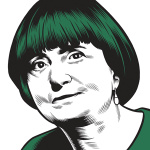Agnès Varda is sitting in a hotel room during the Toronto International Film Festival, and there is a photographer looming in the corner. She doesn’t want him to shoot while she is talking—she insists he do it now. “Don’t take pictures of the others, please! Make no mistake which one is me,” she says. “We have a brunette, here. A blond. You have the choice. Oh my god. Move back!” she cries. “You have a telephoto! Why do you need to be so close? It’s like a gun!”
Six journalists sit around, drinking tea and coffee, all poised to interview her at once. She asks a newspaperman, “Did you get the press kit? It is full of information. You could even invent that you met me. Say, ‘We were in a little room. She had the light behind her because her eyes fear the light. And we had tea and coffee.’”
You have reached your article limit
Sign up for a digital subscription and continue reading all new issues, plus our entire archives, for just $1.50/month.
Already a subscriber? Sign in





